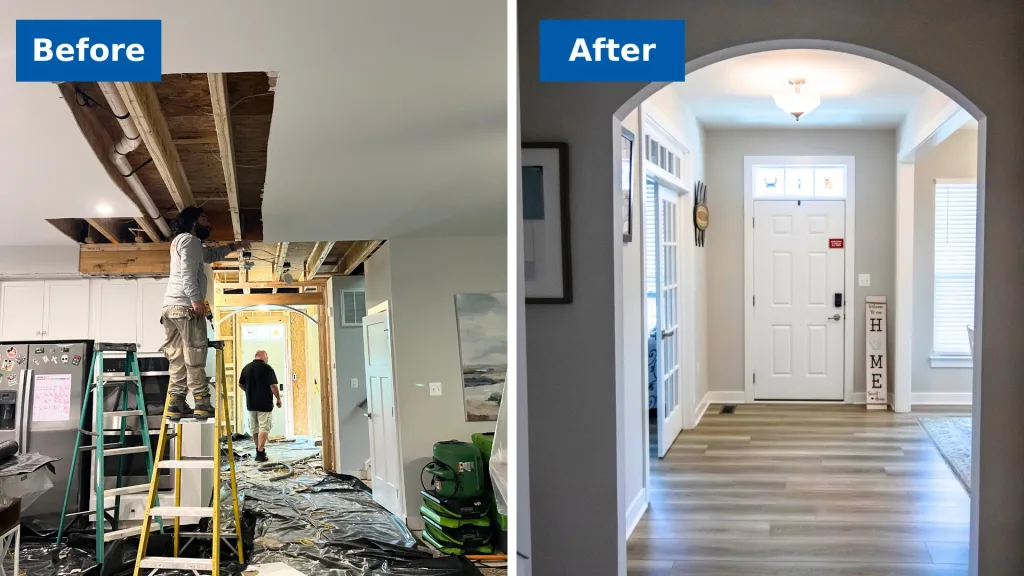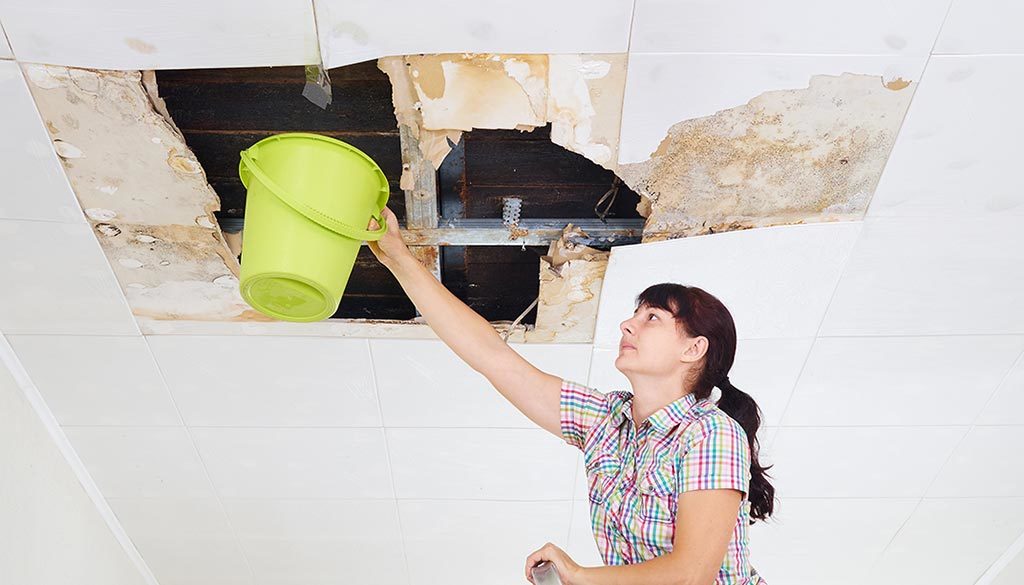Important Steps to Comply With for Effective Water Damage Repair in your house
When confronted with water damage in your house, understanding the vital actions for efficient restoration can make all the distinction. You need to analyze the damage and warranty security prior to dealing with the trouble. Quiting the source of water is essential, yet it's just the start. There's a collection of activities you need to take to protect your building from further problems as soon as you've handled that. Allow's explore what you should do following.
Analyze the Damage
When you find water damages in your house, the primary step is to evaluate the damages thoroughly. Begin by recognizing the resource of the water intrusion. Inspect for leakages, ruptured pipelines, or various other issues creating the trouble. Next off, examine the impacted locations for noticeable indicators of damages, including staining, bending, or mold growth. Don't forget to look in covert areas like behind walls or under flooring, as water can leak into these areas unnoticed.Document the damage by taking clear photos and notes. When going over the circumstance with your insurance coverage company or repair experts, this will assist you. Take note of the type of materials impacted, as different materials require various reconstruction strategies. Ultimately, examine the degree of the damage. Is it substantial or small? Understanding the extent will certainly assist you in making a decision whether to handle it yourself or call the specialists for an extra extensive remediation process.

Guarantee Safety and security
Before you start any repair job, assuring your safety and security is essential. Analyze the problem of your home. If the water's deep or if you notice electric risks, don't go into the area. Turn off the electrical energy and gas supply to stop mishaps. Use safety equipment like gloves, masks, and boots to shield yourself from impurities or mold.It's vital to stay knowledgeable about your environments; expect sharp things and unsafe surface areas. Treat it as harmful waste if the water is from a sewage backup. Keep pet dogs and youngsters away from affected areas to avoid exposure.Once you've taken these precautions, you can proceed with the remediation procedure. Keep in mind, your safety comes first, and if you're ever not sure, it's finest to get in touch with an expert. Taking these steps will certainly assist ensure you're prepared to tackle the repair safely and successfully.
Stop the Source of Water
After guaranteeing your safety and security, the next action is to stop the resource of water. Recognize where the leakage is coming from. It could be a burst pipeline, a malfunctioning device, and even heavy rainwater getting in through a damaged roofing system. If it's a pipes issue, turn off the main supply of water to your home to prevent additional flooding. For appliances, unplug them and shut down their supply of water valves.If the resource is outside, like rain, attempt to divert it far from your home making use of sandbags or other barriers. For minor leakages, you could be able to utilize tape or a sealant momentarily till a professional can fix it. Bear in mind, dealing with the resource rapidly is crucial to decreasing damages and protecting against mold development. When you've quit the water, you'll remain in a much better placement to proceed to the next action in the remediation procedure.

Get Rid Of Excess Water
Act quickly to get rid of excess water, as standing water can cause much more comprehensive damages and mold growth. Collect your tools: a wet/dry vacuum, pails, and towels. If the water is superficial, you can make use of towels to absorb the wetness. For much deeper water, a wet/dry vacuum cleaner is your best choice. Make certain to empty the vacuum cleaner often to prevent overflow.If the water is contaminated, like from a sewer backup, put on safety equipment, consisting of handwear covers and masks, to maintain yourself safe. When you've eliminated as much water as feasible, look for surprise pockets of moisture in corners and under furnishings, as these can nurture mold.Don' t forget to turn off electrical home appliances and power outlets in wet areas to avoid hazards. This initial action is vital in reducing damage and establishing the stage for an effective reconstruction process.
Dry and Dehumidify the Location
It's necessary to dry and dehumidify the area thoroughly once you've gotten rid of the excess water. Start by making use of dehumidifiers successfully to pull wetness out of the air and stop mold growth. Watch on moisture levels to assure the room dries out entirely.
Eliminate Standing Water
To efficiently tackle water damage, you need to concentrate on removing standing water as swiftly as feasible. Start by gathering essential tools, like a wet/dry vacuum cleaner or a pump, relying on the quantity Discover More of water. If the water is superficial, a vacuum cleaner should suffice. For bigger amounts, a pump is a lot more effective. While functioning, ensure to use safety gear to keep on your own safe from impurities. As you eliminate the water, focus on hidden areas like under furnishings or in edges where water could gather. As soon as you have actually gotten rid of the majority, your space will start to dry out. This action is necessary, as lingering water can bring about mold growth and more substantial damage.
Usage Dehumidifiers Successfully
Just how can you successfully utilize dehumidifiers to completely dry and evaporate your room? Beginning by placing your dehumidifier in the most afflicted area, ideally where water damage is most severe. Make certain to close all home windows and doors to produce a sealed atmosphere. Transform on the dehumidifier and set it to the suitable moisture level, typically around 30-50%. Empty the water collection storage tank frequently, or consider utilizing a model with a continual drain alternative for benefit. Preferably, utilize followers to enhance airflow, assisting the dehumidifier work a lot more efficiently. Maintain the dehumidifier running till you're confident that the location is extensively dried out, stopping mold development and extra damage (Water Damage Restoration St George UT). This action is necessary for efficient water damage reconstruction
Monitor Moisture Degrees
Tracking moisture degrees is crucial during the drying procedure, as it aids ensure your room remains without excess moisture. Buy a reputable hygrometer to track humidity precisely. Ideally, you want to keep levels between 30% and 50%. If humidity readings increase above this variety, you may require to readjust your fans or dehumidifiers to improve air flow. Examine the readings frequently, especially in locations vulnerable to dampness, like basements or washrooms. Think about enhancing ventilation or using additional dehumidifiers if you see persistent high moisture. Remaining on top of these degrees not just speeds up the drying out process however additionally prevents mold growth, guaranteeing your home remains safe and comfortable.
Clean and Disinfect Affected Surfaces

Recover and Fix Your Home
After cleansing and decontaminating the impacted areas, it's time to recover and repair your home. Begin by assessing the damages. Look for structural concerns, like weakened walls or floors, and resolve any essential fixings. Changing damaged drywall or flooring is important for both visual appeals and safety.If your furnishings or valuables were influenced, take into consideration whether they can be restored or need replacement. Tidy or professionally recover things where possible.Next, touch and repaint walls up any locations that need attention. This not just improves look but additionally secures surfaces from future water damage.Don' t fail to remember to check your plumbing and devices for leakages, making sure everything's functioning correctly. Consider mounting a dehumidifier to prevent future dampness concerns. By taking these steps, you'll restore your home to its previous magnificence and produce a much safer living environment.
Regularly Asked Questions
How Long Does Water Damage Restoration Commonly Take?
Water damage remediation commonly takes anywhere from a few days to several weeks, depending on the degree of the damages (Water Damage Repair). You'll desire to assess the circumstance swiftly to reduce more problems and assure correct repair
Will My Insurance Policy Cover Water Damages Remediation Prices?
Your insurance policy might cover water damages restoration expenses, yet it depends on your plan. Examine your protection information and contact your insurance agent to clarify what's consisted of and what you require to sue.
Can I Manage Water Damage Restoration Myself?
You can deal with water damages repair on your own, yet it's important to assess the circumstance. You might want to call specialists if it's extensive. Constantly focus on security and assure you have actually obtained the right tools.
What Are the Indications of Hidden Water Damage?
You might see signs of surprise water damages like distorted walls, moldy smells, or staining. If your floors really feel squishy or you spot mold and mildew, it's time to investigate better prior to the situation gets worse.
Just How Can I Protect Against Future Water Damage in My Home?
To protect against future water damage in your home, you ought to frequently inspect pipes, seal splits, maintain gutters, and assurance proper water drainage. Setting up a sump pump and moisture barriers can likewise assist my site maintain your area dry. When you discover water damage in your home, the initial action is to assess the damage thoroughly. Act quickly to get rid of excess water, as standing water can lead to a lot more extensive damages and mold development. To successfully deal with water damage, you need to focus on eliminating standing water as promptly as possible. As you eliminate the water, pay focus to hidden areas like under furnishings or in corners where water might gather. Water damages remediation typically takes anywhere from a few days to a number of weeks, depending on the extent of the damage.